Blog post by Gabriela Arce.
Haga clic aquí para verlo en español.
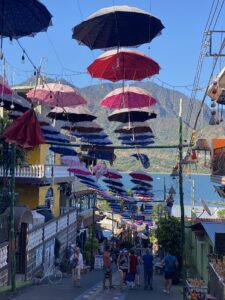
Step into my country, Guatemala—into San Juan La Laguna, one of twelve Indigenous towns that circle the sacred waters of Lake Atitlán. Surrounded by three majestic volcanoes and steeped in Mayan cosmology, this region is more than visually breathtaking—it’s an ancestral energy vortex, alive with memory, meaning, and mutual care. In San Juan, walls come alive with vibrant murals that echo the stories and spirit of its people. In this landscape, women-led cooperatives are weaving not just cloth, but new social realities rooted in Indigenous knowledge and solidarity.
Each of the twelve towns around Lake Atitlán speaks its own Mayan language and weaves its own identity into cloth. Their distinct patterns, color palettes, and textile traditions are more than artistic expression—they are acts of continuity and cultural pride. Through the hues and motifs, each community tells a story: of mountains and maize, of ancestors and aspirations.
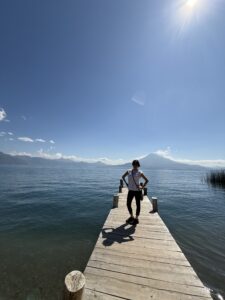
I remember arriving in San Juan for the first time in an old wooden boat, the sacred xocomil wind stirring the surface of the lake and something deep within me. San Juan didn’t just welcome me—it recognized me. The land here pulses with purpose. In Maya belief, Lake Atitlán holds ancestral energy—where ceremony, land, and spirit converge. This is sacred ground, and it’s no accident that cooperatives are flourishing here.
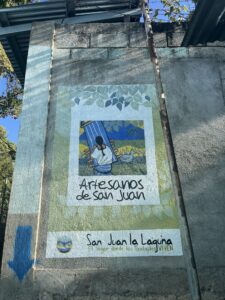
In San Juan La Laguna, predominantly Tz’utujil Maya, weaving has always been an act of cultural transmission. Today, it’s also an act of collective empowerment. Cooperatives such as the San Juan Women’s Weaving Cooperative, Artesanos de San Juan, Lake Atitlán Women Weavers Co-op, and Lema’ Weaving Association have become instruments of transformation. These collectives allow women to lead enterprises grounded in ancestral practice and shared governance, reclaiming economic agency for the present and future.
Women in these cooperatives share resources, govern democratically, and invest earnings directly into their families and communities. Many live in communal homes where support is woven into daily life. They are sending their children to school—often for the first time—and shaping a future rooted in self-determination.
Each cooperative centers traditional practices: hand-spun cotton, plant-based dyes, and the backstrap loom. These aren’t just crafts; they are poetic testaments of resilience. The rhythmic cadence of loombeats becomes a form of meditation, of renewal, of joy. Through their artistry, these women spin threads of past and future into garments that shimmer with intention, heritage, and pride.
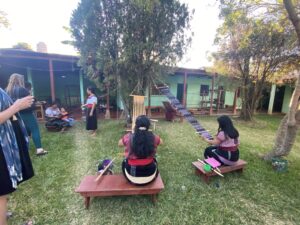
Lema’ Weaving Association, founded by a collective of women artists, reinvests profits into community education. They teach natural dyeing methods using native plants and offer workshops that preserve Tz’utujil culture and build global solidarity. Casa Flor Ixcaco, another powerhouse cooperative, was formed by women who rejected synthetic dyes and intermediaries. Instead, they re-centered their work around ethical labor and ecological harmony. The cooperative model has allowed them to retain full control over their production and pricing—shifting the balance of power back to the weavers themselves.
Cooperatives such as Asociación Ixoq Ajkeem and Asociación Maya Kotz’ij, also based around Lake Atitlán, work across multiple villages to expand the impact of weaving, natural dyeing, and cultural preservation. These networks amplify the voices of Indigenous women, build regional solidarity, and promote ecological sustainability through regenerative agricultural practices.
These spaces are also leadership incubators. Through the cooperative model, women gain skills in financial literacy, conflict resolution, marketing, and governance. They learn how to negotiate with wholesalers, organize direct sales, and advocate for their rights locally and globally. These aren’t just artisan groups—they are schools of solidarity economics.
San Juan is one of many towns around Atitlán where cooperative power is being reclaimed. In communities such as Panajachel, Santa Cruz, and Santiago Atitlán, women-led cooperatives are reviving ancestral arts and anchoring new economies rooted in dignity, mutual aid, and ecological balance.
Cooperatives are the heartbeat of this transformation. They allow communities to remain rooted in place while reaching across borders with their stories, their crafts, and their vision of a world that values life over profit. Through each cooperative, women are writing a shared future—one dyed thread, one decision, one loombeat at a time.
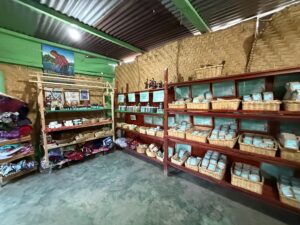
As we celebrate the International Year of Cooperatives, San Juan La Laguna offers a living lesson: true resilience is collective. Their story is more than inspiration—it is a call to action. A call to recognize and invest in cooperative ecosystems, honor Indigenous knowledge, and trust women’s leadership as a force for global change. Among volcanoes and sacred waters, these weavers are not only preserving culture—they are redefining it, on their own terms.
In every dyed thread and shared decision lies a deeper truth: when women come together in cooperatives, they don’t just sustain tradition—they shape the future.
